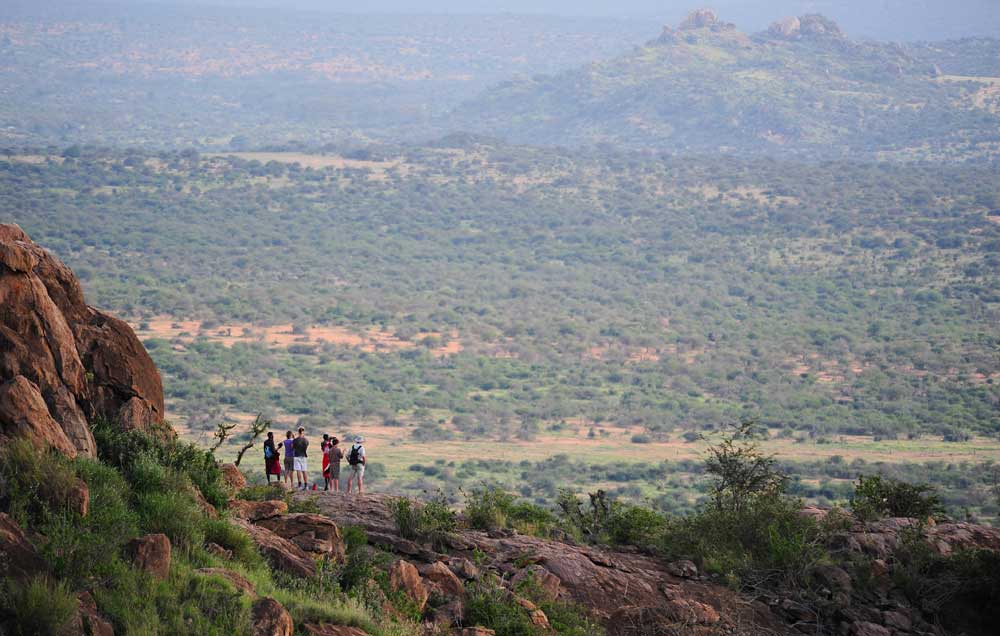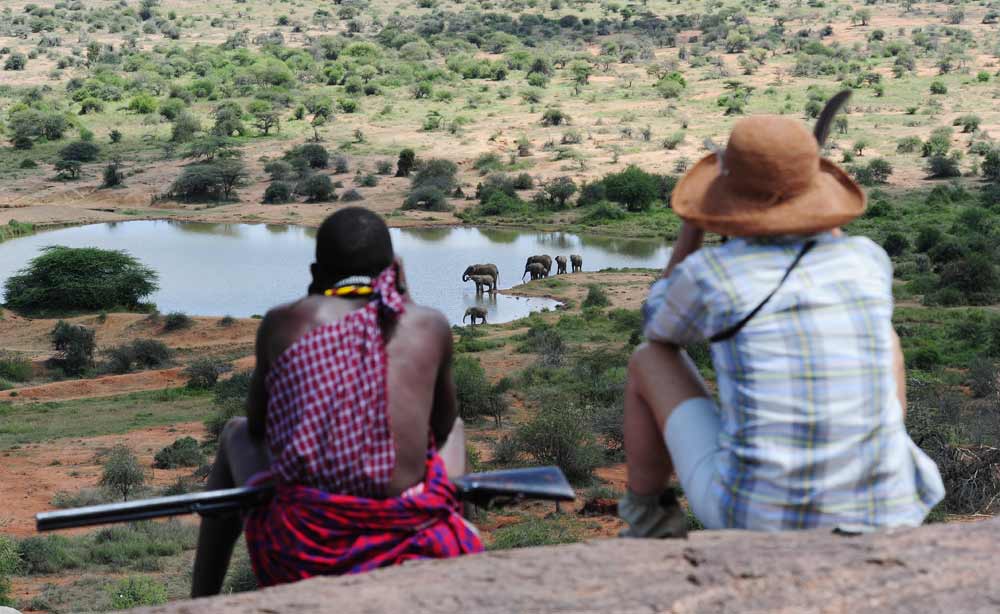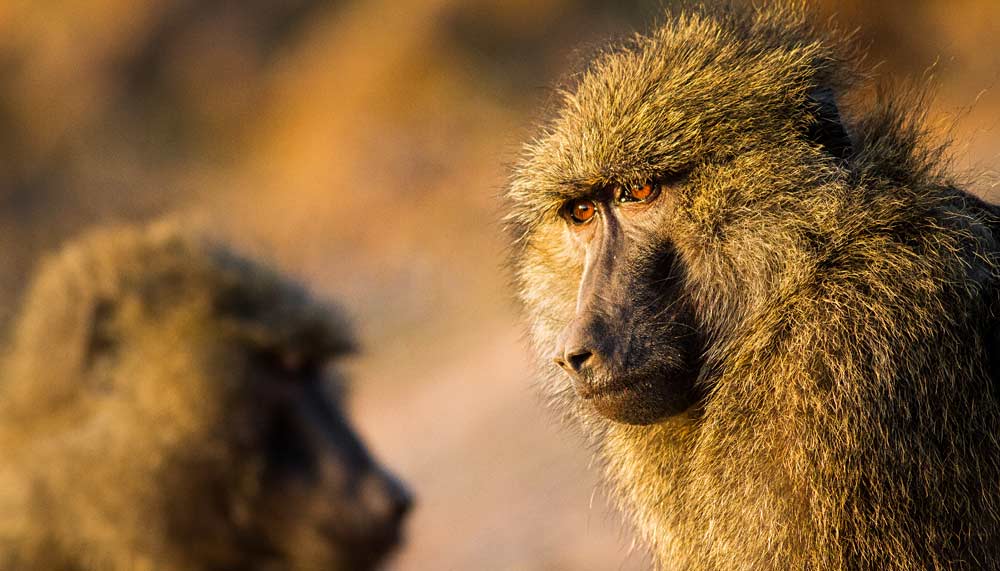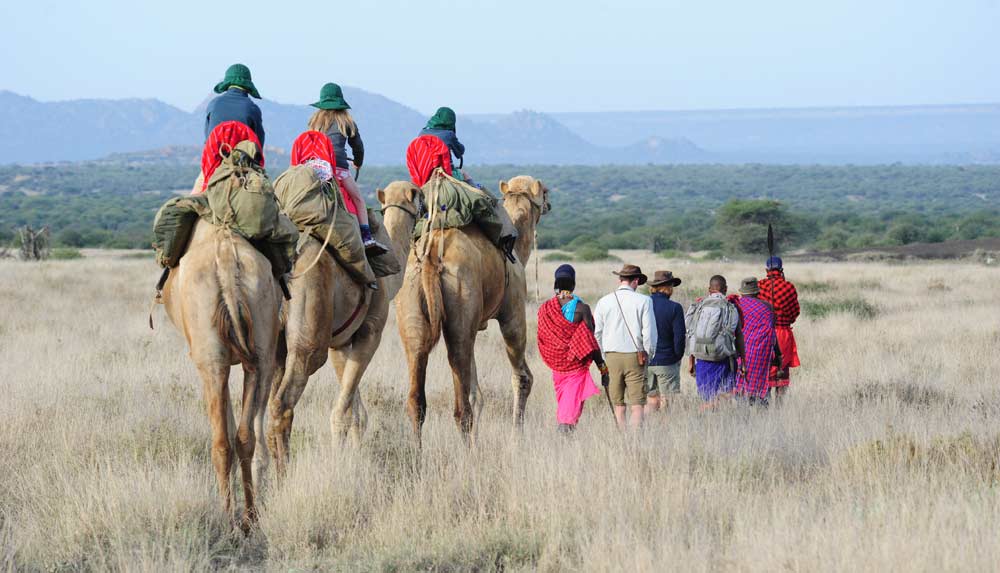A walking safari in Laikipia makes a great way of seeing this enchanting region of Kenya; a great way of getting exercise too. A walking safari is also an unrivalled way of getting to know your Samburu guide. Finally, there is no better way of seeing elephants…


Climbing a kopje
A walking safari takes commitment. It’s a hard, clawing, slithering scramble up the kopje, a vast cluster of giant-sized golden boulders the size of an airplane hangar. The plains below Mount Kenya are littered with these outcrops. Some rear like jagged towers, others crouch like monstrous muffins. After twenty minutes of increasingly difficult scrabbling up sun-warmed rock, we’re finally on top. Buffeted by a strong wind that wasn’t present down below, we gaze out across miles and miles of rolling acacia.
Awesome is an over-used word. But in this case it does the job. Dusk is falling and the great grey shoals of hills are slowly turning pink. Shafts of silver light fan down from the heavens.

There’s another great kopje facing us. It’s the size of an Easter Island statue and resembles the profile of a gigantic baboon. Scampering up its huge face, like an outbreak of spots, is a baboon troop. There must be twenty or thirty of them and they’ll spend the night up there: safe from lions and leopards. High above, a tawny eagle circles, his wing tips flipped to catch the updraft. So perhaps they safety isn’t entirely guaranteed.
The arrival of the elephants
‘Can you see the elephants?’ asks our Samburu guide. He unslings his gun and balances it on his lap. He, of course, has known they were there all along. He’s spotted their great pancake prints in the dust, heard the cracking of branches as they strip bark. It’s his job. We, however, take several seconds of straining to disentangle the grey-brown humps of the elephants from the grey-white clumps of bush. When we finally succeed, it comes as a shock: the bush, hitherto so innocent, has revealed fifteen elephants. Quite a concealment, but then Mother Nature is the mistress of the slow reveal.

We watch as a great she-elephant uses her trunk to snap off a branch of spine-laden acacia and cram it into her mouth. It’s devoured with all the ease of a twirl of spaghetti on a fork. In the cave of her legs a baby is suckling. A pair of adolescent males twines trunks in mock fight. Sisters, cousins and aunts forage companionably together. It’s supper time at baboon rock.
The baboons show up

We’ve descended from the heights to a lower ledge: out of the wind, closer to the vehicle, and the young Samburu warrior who hauled us up the steeper parts of the climb is unpacking his rucksack. There’s a bottle of chilled wine, cans of Tusker lager and a large bowl of popcorn still warm from the kitchens of Karisia Walking Safaris. As the cans pop open, a face peers enquiringly over the rounded lip of the rock above. And then another, and another until the whole bulge of rock is fringed with faces. This is another troop of baboons and they’ve returned home to find somebody sitting on their ledge. After surveying us for some seconds, they retreat. They’ve met men before.
The great bull elephant arrives
Our guides are exchanging remarks. Joseph grabs his binoculars. Down the track comes a veritable giant of an elephant. He’s moving fast: ears flapping, trunk swaying. Deep in the grey tangle of bush the females seem unaware of his approach. This might be awkward. Cows don’t welcome the attention of bulls unless it’s the mating season. This bull, however, has the air of one who is not to be denied. ‘They’ll warn him off,’ says Joseph. Right on cue there’s a cacophony of trumpeting and the females draw closer together. The big bull is undeterred. He plunges into their midst until he’s trunk to trunk with the matriarch. It’s a stand-off.
Through the binoculars we can just make out the approach of a young female. She sashays up to the bull and rubs her head against his great grey ribcage. His trunk comes up and, very delicately, he sniffs her. Others females approach and there’s an orgy of sniffing. Trunks curl and wind around each other. And then, as if satisfied by the tenor of his welcome, the bull turns to an acacia tree and effortlessly rips it in two. The cows return to their foraging. Peace is restored at baboon rock.
What you need to know when planning a walking safari in Laikipia

Karisia Walking Safaris, based in Laikipia County, offer bespoke walking safaris (with or without camels). It’s a superb experience, not just because the scenery is stunning and the wildlife some of the finest in Kenya, but also because you are introduced effortlessly into the colour and culture of Samburu life and to the towering magnificence of Laikipia, which hosts thousands of elephants, huge lion herds, spectacular birdlife and the largest population left on earth of endangered mammals such as Grevy’s zebra, wild dogs and reticulated giraffe.
For further information: www.karisia.com
© 2025 Kenya Holidays
